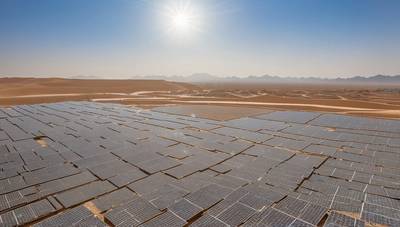China uses solar panels to fight desert sands
In the arid north of China, workers trim goji berry plants that are spread out under the protection of thousands of solar panel.
The solar panel facility of 1 gigawatt in Ningxia, a region in northwest China, is part of an extensive network that uses the shade and bulk of the panels to reverse desertification.
Vice-chairperson Liu Yuanguan of Ningxia Baofeng said that the company, which is a major player in the coal chemicals industry, intends to build 30GW of solar power, of which some will be used to prevent desertification. He added that a similar 1 GW solar project is already in place in Majiatan, which is nearby.
Liu, who was accompanied by the Chinese government on a tour of this facility, said that the panels were like miniature umbrellas. They are casting shadows over the soil and plants to reduce evaporation.
Around a quarter is classified as "desertified", and campaigns to contain the sands and reclaim them date back to the 1970s. The solar panels that are being installed on the sun-baked deserts, which are empty and void of life, is a relatively new weapon.
Solar power was incorporated in the September revision of the flagship anti-desertification "Three Norths", which began in 1978, and will last until 2050. However, the concept had been mentioned in planning documents dating back to 2021.
Standard practice is to use shade panels for the desert-hardy shrubs and seeds that are planted underneath, while barriers surrounding the site slow down wind speeds and prevent sand movement. According to the Ningxia Government, it can take five years for results to be seen.
Solar panels are installed in China every year at a rate of hundreds of gigawatts. Beijing, however, has plans to increase the number of projects that use solar energy to combat desertification.
Solar panels can be built in deserts to preserve farmland. China will ban solar panels from arable lands in 2023. State media has also criticized solar panel construction on prime farmland.
According to the state media, the National Development and Reform Commission and two other agencies have plans for China to install 253 GW solar between 2025 and 2030 to rehabilitate an area of approximately 7,000 km2 (2,700 sq miles), which is about four times as large as Greater London.
In comparison, the United States installed more than 50 GW solar power last year.
The NDRC has not responded to any questions regarding the plan.
Progress is difficult to achieve, whether it's through solar panels or alternative methods such as tree planting. Last year, desertified land accounted for 26.8% of China's total area. This is down from 27.2% 10 years ago despite massive tree-planting programs.
In the Baijitan Nature Reserve, located several hours from Baofeng, decades of hard work have reclaimed 800 square kilometers.
Director Wang Xiaoling of the site says that the aim is to minimize damage, not to completely wipe out deserts.
He said, "It's a long-term war to control desert." "We cannot say that we will be able to wipe it out entirely."
(source: Reuters)


